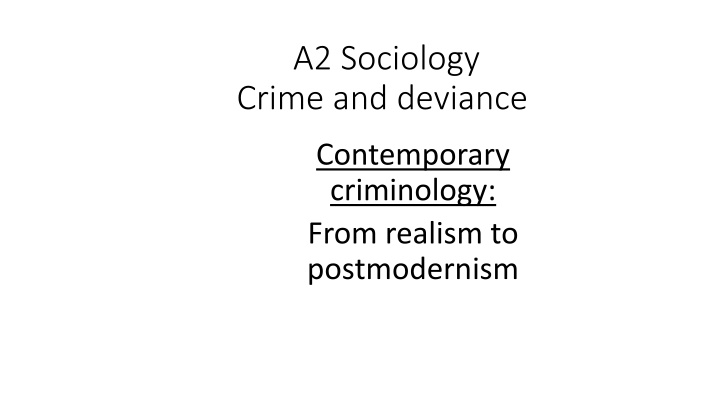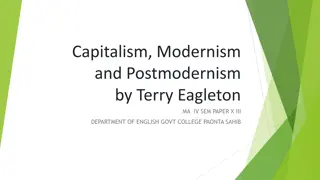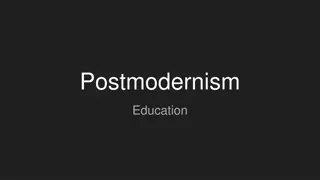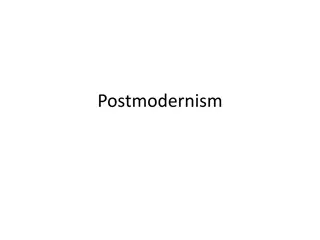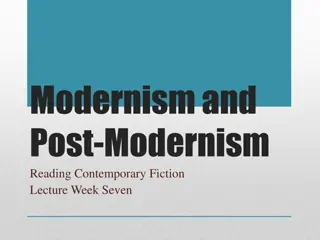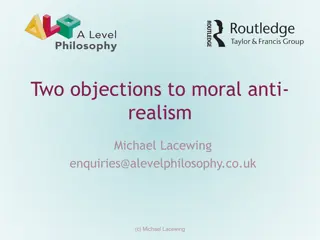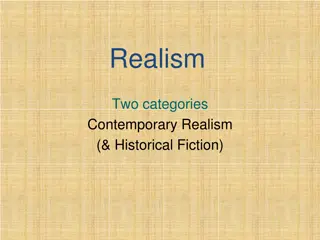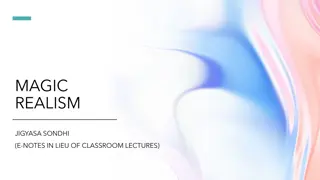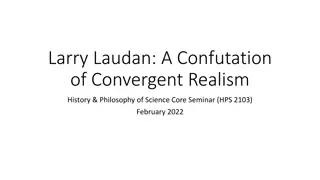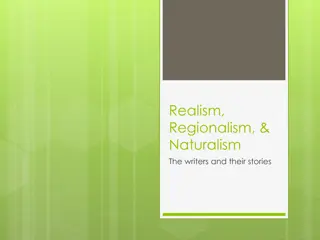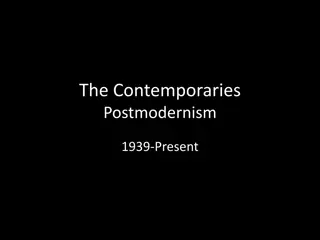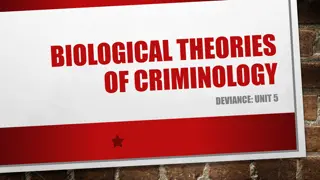Contemporary Criminology: Realism to Postmodernism
Criminology has evolved from Right Realism with a focus on social control breakdown to Left Realism emphasizing tackling deprivation. Explore the development of these theories in the context of crime and deviance, impacting policing strategies and community dynamics.
Download Presentation

Please find below an Image/Link to download the presentation.
The content on the website is provided AS IS for your information and personal use only. It may not be sold, licensed, or shared on other websites without obtaining consent from the author.If you encounter any issues during the download, it is possible that the publisher has removed the file from their server.
You are allowed to download the files provided on this website for personal or commercial use, subject to the condition that they are used lawfully. All files are the property of their respective owners.
The content on the website is provided AS IS for your information and personal use only. It may not be sold, licensed, or shared on other websites without obtaining consent from the author.
E N D
Presentation Transcript
A2 Sociology Crime and deviance Contemporary criminology: From realism to postmodernism
Realist criminology Right Realism Deriving from the right wing theories of James Q Wilson and emphasising zero tolerance . Left Realism Deriving from the writings of Lea, Young and Matthews who emphasise the importance of tackling deprivation and of getting policing to respond to the needs of the local population.
Right Realism Broken Windows (1982) argued that crime flourishes in situations where social control breaks down. According to his analysis a proportion of the population are likely to indulge in incivilities which consist of things such as dropping litter, vandalism or rowdy behaviour. In most communities this behaviour is prevented by comments from other members. However if these incivilities go unchecked then the entire social order of the area breaks down and gradually there is more and more crime-eventually serious crime. Wilson:Abandoned building- he asks if anyone has ever seen just one window broken? The answer was of course that once one window was broken then they all were
Right Realism Once crime is allowed to happen it flourishes. Wilson was strongly influenced by the work of Etzioni (1993) Communitarianism. Which stresses the fact that only local communities by their own efforts and local face to face relationships can solve social problems. Wilsons conclusion was that police should have a crucial role to play in restoring the balance of incivilities and helping recreate communities. He claimed that most police officers engage in law enforcement- ensuring that the law is not broken. (this didn t work and there is a very low prosecution rate) He argued that they should be concentrating on order maintainance using the law to ensure the smaller incivilities are crushed (eg rowdy youths, noisy parties etc) Wilson believed that this would create a different view of what behaviour was acceptable and would make public areas feel safe again for the majority of people.
Right Realism A version of Wilsons ideas was adopted in New York . Zero Tolerance saw a big decline in crime and was then adopted throughout America and parts of the UK. Platt & Takagi (1977) criticise this approach for concentrating exclusively on working class crimes and ignoring the crimes of the powerful. They go on to say that it ignores ideas of justice and law enforcement and advocates instead the maintenance of social order- even if it is at the expense of justice.
Left Realism Developed as a response to right realism. USA (Elliot Currie) UK (Young, Lea & Matthews) Young was one of the founders of critical criminology that introduced elements of interactionist theory into Marxism in order to provide a complete theory of crime. Young (1986) argued that it is the role of criminology to provide relevant and credible solutions for policymakers to limit the harm that crime was doing to the lives of the poorer sections of the community.
Left Realism This approach led to a bitter debate in sociology, with many left wing criminologists attacking young for selling out. Young responded by labelling Marxist criminology as left idealism meaning that it was great in theory but had no solutions. The left realist explanation of crime has three elements. Relative deprivation, marginalisation and subculture.
Relative deprivation This derives from the writings of Runciman (1966) who argued that the political revolutions only occurred when the poor became aware of the sheer scale of the differences between themselves and the rich. Without this knowledge they generally accepted their poverty and powerlessness. It is not therefore poverty that leads to revolution but awareness of their relative poverty. Lea & Young (1984) applied this concept to crime and pointed out that poverty or unemployment do not directly cause crime. In times of economic depression the crime rate is often lower. Young people feel resentful at what they could actually earn compared with their aspirations.
Marginalisation Certain groups in the population are more likely than others to suffer economic, social and political deprivation. The first two- living in inner city estates is well known they are likely to suffer more than affluent areas. The third element is less known- this is the fact that there is no way for them to influence the decision makers, and thus they feel powerless.
Subculture Subcultures develop amongst groups who suffer relative deprivation and marginalisation. Lea & Young (1984) claim subcultures are still located in the values of wider society. They develop because their members subscribe to the dominant values of society but are blocked off (because of marginalisation) from success. The result is street crime and burglary, committed largely by young males.
Criticisms of left realism Marxists have criticised Realism for ignoring the real causes of crime that lie in the wider capitalist system. They also ignore the crimes of the powerful simply concentrating n street crime. Feminist & postmodern criminologists such as Carlin (1992) and Henry & Milovanovich (1996) argue that left realist writers accept the establishment views of what crime is and so concentrates it attention on issues to do with street crime. They should be exploring the way society harms less powerful groups.
Late Modernity and crime. Late modernity refers to Changes in the economy from production to service industries Growth of global as opposed to national economies Decline in traditional social institutions such as social class and family- and their replacement with greater emphasis on individual identity and aspirations. Growth in importance of the mass media.
Actuarial approached to crime Giddens (1999) & O Malley (1992) suggest that in late modern society, individuals and government are less concerned with justice being done than they are about limiting the risk to themselves. Actuarial approach is taken when the governments are concerned about risk. This term is taken from insurance companies who work out what the risks are for a particular problem then base their charges on that. Therefore gov ts are not concerned with individual guilt or innocence, but with controlling the behaviour of potentially deviant groups. Through such reasoning young people are seen as a problem group and a range of legal measures such as ASBO s are brought in to control everyone.- before the offence is committed. Actuarial theories do not explain crime- they do provide a different way of understanding how societies respond to very high levels of crime.
The criminology of the other Garland (1996)-the idea that there is a lack of difference between the criminal and the law abiding . He claimed that criminals are divided into two types: Criminology of the self. Based on the idea that these criminals are similar to the majority of the population- rational and self seeking. Therefore ordinary people must engage in sensible activities to limit the risk of violence or theft. Don t go to poorly lit areas, lock up possessions etc. Criminology of the other. Refers to those on the borders of our understanding- child molesters, rapists and terrorists. These people are outsiders by whom we truly feel threatened and should be excluded from normal standards of justice and punishment.
